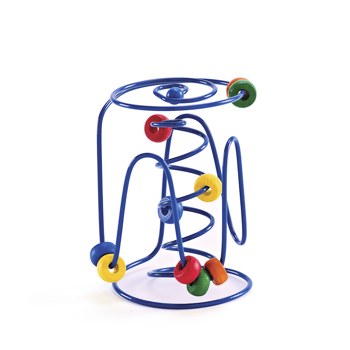Peter Handstein founded Hape as a small educational toy company in Germany 25 years ago. Today, Hape International is a multifaceted, multinational company with distribution in more than 50 countries. It ‘s one of the world’s largest producers of wooden toys, and was the first company to have a full line of bamboo.
The state-of-the-ecology factories in China are efficient and economical. With a sales team and designers from all over the world, Hape toys has an international sensibility— neither limited nor defined by culture, language, or gender. The classic wire and bead Spring-A-Ling is ubiquitous in every doctor’s office. Games such as Pallina and the solar-powered Bamboo Sunshine Dollhouse have won numerous industry awards. Peter himself is a true global citizen: as charismatic in English as he is in German and Mandarin; an entrepreneur, adventurer, and visionary. I recently sat down with him to find out how someone so progressive in so many ways, remained true to his wooden roots when it came to toys. Here’s what he had to say about his vision for Hape…and the future of toys.
W: For years, Hape was known for beautiful wooden toys from Germany. But you moved to China 16 years ago and your business is thriving. What made you come here in the first place?
P: In order to grow and still make high quality commercial toys, I needed lots of labor. China provided that. I came here as a team with 2 others and we hired, educated and monitored our people to build the most efficient and economical workforce and work place we could imagine.
W: You obviously embrace technology in the way you run your factories and business. Yet your toys remain as simple as those you played with as a child. Since we all agree that kids learn through play, don’t you think in the 21st century, they need to be playing with technology?
P: Knowing how to use — and play with— technology are skills everybody needs today. But I don’t think technology toys are necessary when kids are very young. Our products provide an alternative. To me, it’s more important for the development of kids under three to have exposure to nature and beauty. Which would you rather have your child do: create a town using simple bamboo blocks or watch a video? There’s a time and place for everything.
W: Speaking of bamboo, Is this the next big thing?
P: Bamboo is an amazing, and highly sustainable resource. In 3 months, it grows to full height. Every four years, it can be harvested. We’re using it more and more—but it’ll never replace wood. Each material has different properties and can be used in different ways.
W: Hape has its own bamboo forest in China. How does this fit into your master plan?
P: In the next decade, the bamboo and the China markets are both going to continue to grow. I also believe exporting is going to become more difficult and expensive. I want to extend the size of our current bamboo forest about 4 or 5-fold. This will position us to meet global demand, as well as service the China market—which quite possibly could become our largest.
W: Your factories maintain a Total Product Life Cycle approach to manufacturing. A sustainable supply chain, in-house water treatment, and alternative energy sources create ecological solutions to everyday challenges. You obviously thought through the whole production cycle to reach this place. How are you positioning yourself for the next decade?
P: In the next 10 years, I think it’ll be even more important for production to move closer to its source. Right now, 95% of our wood comes from Russia, Australia, and New Zealand. Next year, we’re opening a manufacturing facility in Russia. We also plan to take over a company in Romania.
W: What’s your biggest challenge?
P: People are always the greatest resource and the biggest struggle. I’m willing to try out 100 good people to find one great one. My grandfather taught me that you can’t change people…but you can nurture them. I have 1000 employees in the company, many have literally grown up with us.
W: How about from a product point of view?
P: Commercialization is a constant struggle. What makes a toy attractive to parents and fun for kids? And not just fun for a day or a week. Interactive is a word that’s used all the time. A classic puzzle, a tower of blocks, a play kitchen—these are all interactive toys. You don’t need sounds and lights to spark imagination.
W: Hape toys are traditionally sold in specialty stores. Are these a dying breed?
P: The biggest obstacle facing specialty retailers is to develop traffic. To do so, they’re going to have to integrate other lifestyle products into their mix and transform their stores into shopping experiences. Books, baby products, and yes, electronics, are going to bring in customers. The mom-and-pop toy store is no longer a valid model.
W: What about you? You just turned 50. Where will you be in the next 10 years?
P: When you’re in your 20’s it’s the time to learn. In your 30’s is when you execute. In your 40’s, you’re a teacher. Now that I’m 50, it’s time to strategize for the future. In my 60’s and beyond, I’ll be a consultant. I don’t ever see myself retiring.





















